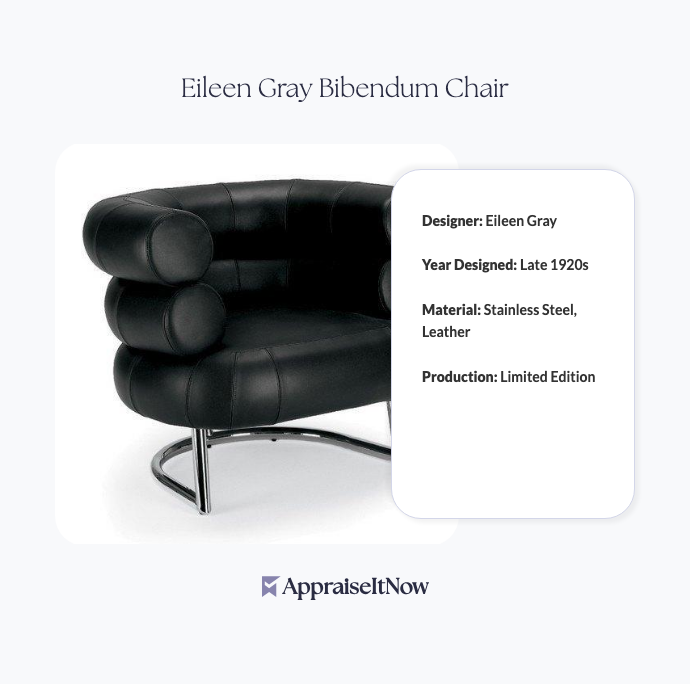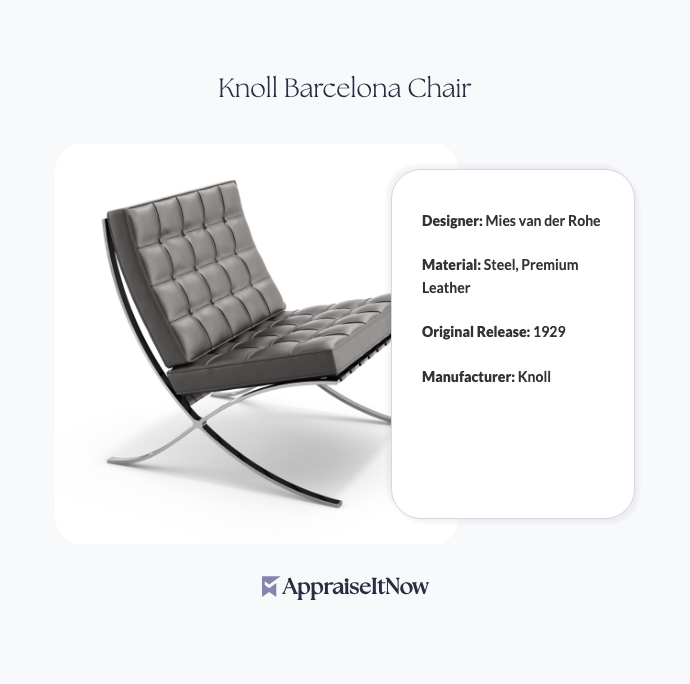<h1>How to Get Your Eileen Gray Bibendum Chair Appraised</h1>
<p>The <strong>Eileen Gray Bibendum Chair</strong> stands as one of modernism's most iconic furniture pieces, commanding valuations between <strong>$6,000 and $10,000</strong> in today's collector market. If you own or are considering acquiring this legendary design, understanding how to properly appraise it ensures you have accurate documentation for insurance, sale, or collection management purposes.</p>
<h2>Understanding Your Bibendum Chair's Historical Significance</h2>
<p>Eileen Gray, a renowned Irish architect and furniture designer, created the Bibendum Chair in the <strong>late 1920s</strong>, capturing the essence of modernist design during a transformative period in decorative arts. The chair's distinctive <strong>curved, tubular steel frame</strong> and deep leather seat embody the minimalist aesthetic that defined the era, making it far more than functional seating—it's a design artifact that influenced generations of furniture makers.</p>
<p>When was the Bibendum Chair first designed? The late 1920s introduction positioned it alongside other groundbreaking modernist works, giving your chair potential historical significance beyond its materials. What makes this particular piece so collectible is its <strong>extreme scarcity</strong>. Gray produced only limited numbers during her lifetime, creating artificial scarcity that drives collector demand today. This rarity factor, combined with the chair's proven influence on modern furniture design, explains why even well-used examples command premium prices.</p>
<div class="callout tip"><p><strong>Historical Context</strong></p>
<p>Pieces with documented provenance linking them to design movements or notable collections can command 15-25% premiums over undocumented examples.</p></div>
<h2>Key Factors That Determine Your Chair's Appraisal Value</h2>
<p>The Bibendum Chair's value depends on several interconnected factors that professional appraisers evaluate systematically. Unlike mass-produced furniture where condition and age dominate pricing, modernist design pieces like your Bibendum involve more nuanced assessment.</p>
<p><strong>Materials and Construction Quality</strong> form the foundation of valuation. Your chair's <strong>stainless steel frame</strong> and leather upholstery represent significant material investment, but equally important is the craftsmanship evident in the execution. The tubular steel construction requires precision bending and welding, with authentic pieces displaying consistent joinery and proportions that distinguish them from later reproductions. Original leather, even with aging or patina, often commands premiums over re-upholstered examples among sophisticated collectors who value design authenticity.</p>
<p><strong>Production Period and Authenticity</strong> significantly impact pricing. Original pieces manufactured during Gray's lifetime (or shortly after under her direct supervision) command substantially higher values than later reproductions or licensed reissues. Professional appraisers verify authenticity through construction techniques, materials analysis, and documentation review. When seeking an <a href="/types/antique-furniture">antique furniture appraisal</a>, confirming whether your chair represents an original production run versus a modern reissue becomes essential for accurate valuation.</p>
<p>Condition assessment requires specialized knowledge of modernist furniture preservation. Unlike <a href="/blog/understand-the-value-of-antique-furniture-examining-quality-and-rarity">antique furniture</a> where restoration often enhances value, modernist pieces present a paradox—original patina and wear can indicate authenticity, yet safety and functionality concerns may justify careful restoration. The structural integrity of your frame, functionality of joints, and condition of leather upholstery all factor into the final appraisal value. A chair retaining original leather with appropriate aging may actually be valued higher than one restored to pristine condition, depending on the collector market segment.</p>
<div class="callout note"><p><strong>Appraisal Insight</strong></p>
<p>The most valuable Bibendum Chairs combine original manufacturing, documented provenance, and appropriate condition that demonstrates authentic use rather than museum-like sterility.</p></div>
<h2>Recognizing Reproduction vs. Original Bibendum Chairs</h2>
<p>Understanding reproduction status is critical for accurate appraisal. The Bibendum Chair entered licensed production in subsequent decades, with various manufacturers creating interpretations ranging from faithful reproductions to significant departures from Gray's original design. Original pieces from the 1920s-1930s era command valuations at the <strong>$6,000-$10,000</strong> range, while authenticated licensed reproductions might appraise at <strong>$1,500-$3,000</strong>, and contemporary interpretations could fall below <strong>$1,000</strong>.</p>
<p>How can you tell if your chair represents an original versus reproduction? Several indicators help distinguish versions. Original Gray pieces feature specific construction details that vary from later interpretations—joint configurations, leather sourcing characteristics, steel finish methods, and frame proportions all tell a story about manufacturing era and authenticity. Professional appraisers use comparative analysis, materials examination, and documentation review to establish authenticity with confidence suitable for insurance and transactional purposes.</p>
<p>This distinction mirrors the broader <a href="/types/furniture">furniture appraisal</a> market, where understanding manufacturing provenance directly impacts valuation. Just as collectors of <a href="/types/household-goods">household goods</a> benefit from professional verification, Bibendum Chair owners gain significant confidence and documentation through certified appraisals.</p>
<h2>The Role of Provenance in Valuation</h2>
<p>Documented ownership history substantially elevates Bibendum Chair valuations. A chair with clear provenance linking it to notable design collections, institutional holdings, or documented exhibition history can be valued 20-30% higher than an equivalent piece with uncertain background. Conversely, unknown origin doesn't necessarily indicate lower value, but it does limit the premium that sophisticated collectors will pay for historical narrative alongside the object itself.</p>
<p>When compiling provenance documentation for your chair, gather any available evidence: purchase receipts, previous ownership records, exhibition catalogs featuring your piece, published photos or references, and any correspondence from prior owners. This documentation becomes central to professional appraisal reports and significantly enhances your chair's marketability should you decide to sell.</p>
<h2>Market Dynamics and Current Demand</h2>
<p>The modernist furniture market has experienced sustained appreciation over the past decade, with iconic designer pieces commanding increased collector attention. What is the most valuable antique furniture? While museum-quality pieces from specific makers command six-figure valuations, the Bibendum Chair's <strong>$6,000-$10,000</strong> range reflects strong but accessible market positioning. Several factors support continued demand for Gray's work specifically.</p>
<p>First, design history education increasingly emphasizes Gray's contributions to modernism, expanding the collector base beyond traditional furniture specialists to design historians and educational institutions. Second, the finite supply of original pieces means no new competition from contemporary production can satisfy growing demand. Third, Gray's influence on contemporary design creates cultural relevance that sustains collector interest across generations. Understanding these market dynamics helps contextualize your chair's current valuation within broader trends toward design-focused collecting.</p>
<div class="callout tip"><p><strong>Market Insight</strong></p>
<p>Pieces featured in major design exhibitions or publications often see value appreciation as institutional validation influences collector perception.</p></div>
<h2>Why Vintage Chairs Command Premium Pricing</h2>
<p>Why are vintage chairs so expensive compared to modern furniture? Several factors explain price premiums for classic designs. Manufacturing quality in the 1920s-1930s often exceeded contemporary production, with handcrafted details and material selection that modern production economies struggle to match at comparable price points. Scarcity creates artificial value through supply limitation, while design significance adds cultural premium beyond functional utility. When considering what makes furniture truly valuable, the combination of superior craftsmanship, historical importance, and limited availability typically drives pricing.</p>
<p>Your Bibendum Chair benefits from all three factors simultaneously. The craft evident in its construction, the historical significance of Gray's modernist contributions, and the genuine rarity of original pieces all converge to support professional valuations within the <strong>$6,000-$10,000</strong> range.</p>
<h2>Practical Steps for Getting Your Chair Appraised</h2>
<p><strong>Preparing Documentation</strong> forms the foundation of accurate appraisal. Compile clear photographs showing overall form, details of joinery and construction, material conditions, any maker's marks or stamps, and the chair from multiple angles. Gather any existing documentation including purchase receipts, previous appraisals, exhibition catalogs, or historical references. If you have information about prior ownership or provenance, document that thoroughly as well.</p>
<p><strong>Selecting an Appraiser</strong> requires identifying professionals with specific expertise in modernist design furniture. Not all furniture appraisers possess the specialized knowledge necessary to accurately value designer pieces from this era. Look for appraisers credentialed through organizations like <strong>ISA</strong> (International Society of Appraisers) or <strong>AAA</strong> (American Society of Appraisers) with documented experience in <a href="/blog/appraising-contemporary-design-and-furniture-evaluating-modern-artistry">contemporary design and furniture</a>. When evaluating candidates, ask about their experience appraising similar modernist pieces and request references from previous clients.</p>
<p><strong>Platform Accessibility</strong> simplifies the appraisal process significantly. Services like <strong>AppraiseItNow</strong> allow you to submit photographs and detailed descriptions of your Bibendum Chair through a secure online platform, connecting you with credentialed experts who can provide certified valuations without requiring in-person visits. This approach proves particularly convenient for valuable pieces where transportation risks must be minimized.</p>
<p>Professional appraisers evaluate your chair systematically, examining construction quality, material authenticity, condition status, and market comparables to establish fair market value suitable for insurance, estate planning, or sale purposes. The resulting <a href="/blog/how-to-get-an-accurate-antique-furniture-appraisal">USPAP-compliant appraisal report</a> provides documentation accepted by insurance companies, financial institutions, and courts.</p>
<h2>Insurance and Documentation Considerations</h2>
<p>Insuring a <strong>Bibendum Chair valued at $6,000-$10,000</strong> requires documentation that accurately reflects replacement cost in today's market. Standard homeowners policies typically limit coverage for individual furniture pieces, necessitating scheduled personal property coverage or fine art policies tailored to valuable collectibles. Professional appraisals provide the documentation insurers require to establish agreed-upon values, ensuring your chair receives appropriate coverage should loss occur.</p>
<p>Beyond insurance, professional appraisals serve multiple purposes. Estate planning requires documented values for proper asset distribution. Donation to educational or cultural institutions requires formal appraisals for tax deduction purposes. Sale preparation benefits from professional documentation that establishes market positioning and justified asking prices. Understanding how to document your furniture for appraisal purposes ensures you're prepared regardless of future circumstances.</p>
<div class="callout note"><p><strong>Key Takeaway</strong></p>
<p>A certified appraisal of your Eileen Gray Bibendum Chair provides authoritative documentation of its significance, condition, and market value—whether for insurance protection, estate planning, or confident decision-making around purchase or sale. Professional appraisers bring specialized knowledge that ensures accurate valuation while building confidence in this iconic modernist piece.</p></div>







.avif)







